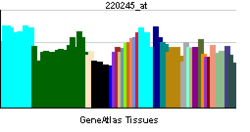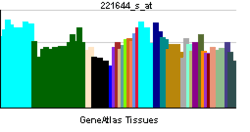SLC45A2
| SLC45A2 | |||||||||||||||||
|---|---|---|---|---|---|---|---|---|---|---|---|---|---|---|---|---|---|
| Identifiers | |||||||||||||||||
| Aliases | SLC45A2, 1A1, AIM1, MATP, OCA4, SHEP5, solute carrier family 45 member 2 | ||||||||||||||||
| External IDs | MGI: 2153040 HomoloGene: 9412 GeneCards: SLC45A2 | ||||||||||||||||
| Genetically Related Diseases | |||||||||||||||||
| melanoma[1] | |||||||||||||||||
| |||||||||||||||||
| RNA expression pattern | |||||||||||||||||
  | |||||||||||||||||
| More reference expression data | |||||||||||||||||
| Orthologs | |||||||||||||||||
| Species | Human | Mouse | |||||||||||||||
| Entrez | |||||||||||||||||
| Ensembl |
|
||||||||||||||||
| UniProt | |||||||||||||||||
| RefSeq (mRNA) | |||||||||||||||||
| RefSeq (protein) | |||||||||||||||||
| Location (UCSC) | Chr 5: 33.94 – 33.98 Mb | Chr 15: 11 – 11.03 Mb | |||||||||||||||
| PubMed search | [2] | [3] | |||||||||||||||
| Wikidata | |||||||||||||||||
| View/Edit Human | View/Edit Mouse |
Membrane-associated transporter protein (MATP) also known as solute carrier family 45 member 2 (SLC45A2) or melanoma antigen AIM1 is a protein that in humans is encoded by the SLC45A2 gene.[4][5][6]
Function
SLC45A2 is a transporter protein that mediates melanin synthesis. SLC45A2 is also a melanocyte differentiation antigen that is expressed in a high percentage of melanoma cell lines. A similar sequence gene in medaka, 'B,' encodes a transporter that mediates melanin synthesis. Mutations in this gene are a cause of oculocutaneous albinism type 4. Alternative splicing results in multiple transcript variants encoding different isoforms.[6]
In melanocytic cell types, the SLC45A2 gene is regulated by microphthalmia-associated transcription factor.[7][8]
SLC45A2 has been found to play a role in pigmentation in several species. In humans, it has been identified as a factor in the light skin of Europeans and as an ancestry-informative marker (AIM) for distinguishing Sri Lankan from European ancestry.[9] SLC45A2 is the so-called cream gene responsible in horses for buckskin, palomino and cremello coloration, while a mutation in this gene underlies the white tiger variant.[10]
See also
References
- ↑ "Diseases that are genetically associated with SLC45A2 view/edit references on wikidata".
- ↑ "Human PubMed Reference:".
- ↑ "Mouse PubMed Reference:".
- ↑ Nakayama K; Fukamachi S; Kimura H; Koda Y; Soemantri A; Ishida T (Mar 2002). "Distinctive distribution of AIM1 polymorphism among major human populations with different skin color". J Hum Genet. 47 (2): 92–4. doi:10.1007/s100380200007. PMID 11916009.
- ↑ Newton JM; Cohen-Barak O; Hagiwara N; Gardner JM; Davisson MT; King RA; Brilliant MH (Oct 2001). "Mutations in the Human Orthologue of the Mouse underwhite Gene (uw) Underlie a New Form of Oculocutaneous Albinism, OCA4". Am J Hum Genet. 69 (5): 981–8. doi:10.1086/324340. PMC 1274374
 . PMID 11574907.
. PMID 11574907. - 1 2 "Entrez Gene: SLC45A2 solute carrier family 45, member 2".
- ↑ Du J; Fisher DE (2002). "Identification of Aim-1 as the underwhite mouse mutant and its transcriptional regulation by MITF". J. Biol. Chem. 277 (1): 402–6. doi:10.1074/jbc.M110229200. PMID 11700328.
- ↑ Hoek KS; Schlegel NC; Eichhoff OM; Widmer DS; Praetorius C; Einarsson SO; Valgeirsdottir S; Bergsteinsdottir K; Schepsky A; Dummer R; Steingrimsson E (2008). "Novel MITF targets identified using a two-step DNA microarray strategy". Pigment Cell Melanoma Res. 21 (6): 665–76. doi:10.1111/j.1755-148X.2008.00505.x. PMID 19067971.
- ↑ Soejima M; Koda Y (January 2007). "Population differences of two coding SNPs in pigmentation-related genes SLC24A5 and SLC45A2". Int. J. Legal Med. 121 (1): 36–9. doi:10.1007/s00414-006-0112-z. PMID 16847698.
- ↑ Xu X; Dong GX; Hu XS; Miao L; Zhang XL; Zhang DL; Yang HD; Zhang TY; Zou ZT; Zhang TT; Zhuang Y; Bhak J; Cho YS; Dai WT; Jiang TJ; Xie C; Li R; Luo SJ (June 2013). "The genetic basis of white tigers". Curr. Biol. 23 (11): 1031–5. doi:10.1016/j.cub.2013.04.054. PMID 23707431.
Further reading
- Harada M, Li YF, El-Gamil M, et al. (2001). "Use of an in vitro immunoselected tumor line to identify shared melanoma antigens recognized by HLA-A*0201-restricted T cells". Cancer Res. 61 (3): 1089–94. PMID 11221837.
- Fukamachi S; Shimada A; Shima A (2001). "Mutations in the gene encoding B, a novel transporter protein, reduce melanin content in medaka". Nat. Genet. 28 (4): 381–5. doi:10.1038/ng584. PMID 11479596.
- Strausberg RL, Feingold EA, Grouse LH, et al. (2003). "Generation and initial analysis of more than 15,000 full-length human and mouse cDNA sequences". Proc. Natl. Acad. Sci. U.S.A. 99 (26): 16899–903. doi:10.1073/pnas.242603899. PMC 139241
 . PMID 12477932.
. PMID 12477932. - Rundshagen U, Zühlke C, Opitz S, et al. (2004). "Mutations in the MATP gene in five German patients affected by oculocutaneous albinism type 4". Hum. Mutat. 23 (2): 106–10. doi:10.1002/humu.10311. PMID 14722913.
- Inagaki K, Suzuki T, Shimizu H, et al. (2004). "Oculocutaneous Albinism Type 4 Is One of the Most Common Types of Albinism in Japan". Am. J. Hum. Genet. 74 (3): 466–71. doi:10.1086/382195. PMC 1182260
 . PMID 14961451.
. PMID 14961451. - Yuasa I, Umetsu K, Watanabe G, et al. (2005). "MATP polymorphisms in Germans and Japanese: the L374F mutation as a population marker for Caucasoids". Int. J. Legal Med. 118 (6): 364–6. doi:10.1007/s00414-004-0490-z. PMID 15455243.
- Gerhard DS, Wagner L, Feingold EA, et al. (2004). "The Status, Quality, and Expansion of the NIH Full-Length cDNA Project: The Mammalian Gene Collection (MGC)". Genome Res. 14 (10B): 2121–7. doi:10.1101/gr.2596504. PMC 528928
 . PMID 15489334.
. PMID 15489334. - Suzuki T, Inagaki K, Fukai K, et al. (2005). "A Korean case of oculocutaneous albinism type IV caused by a D157N mutation in the MATP gene". Br. J. Dermatol. 152 (1): 174–5. doi:10.1111/j.1365-2133.2005.06403.x. PMID 15656822.
- Graf J; Hodgson R; van Daal A (2006). "Single nucleotide polymorphisms in the MATP gene are associated with normal human pigmentation variation". Hum. Mutat. 25 (3): 278–84. doi:10.1002/humu.20143. PMID 15714523.
- Soejima M; Koda Y (2007). "Population differences of two coding SNPs in pigmentation-related genes SLC24A5 and SLC45A2". Int. J. Legal Med. 121 (1): 36–9. doi:10.1007/s00414-006-0112-z. PMID 16847698.
- Lezirovitz K, Nicastro FS, Pardono E, et al. (2006). "Is autosomal recessive deafness associated with oculocutaneous albinism a "coincidence syndrome"?". J. Hum. Genet. 51 (8): 716–20. doi:10.1007/s10038-006-0003-7. PMID 16868655.
- Chi A, Valencia JC, Hu ZZ, et al. (2007). "Proteomic and bioinformatic characterization of the biogenesis and function of melanosomes". J. Proteome Res. 5 (11): 3135–44. doi:10.1021/pr060363j. PMID 17081065.
- Zühlke C, Criée C, Gemoll T, et al. (2007). "Polymorphisms in the genes for oculocutaneous albinism type 1 and type 4 in the German population". Pigment Cell Res. 20 (3): 225–7. doi:10.1111/j.1600-0749.2007.00377.x. PMID 17516931.
- Sengupta M; Chaki M; Arti N; Ray K (2007). "SLC45A2 variations in Indian oculocutaneous albinism patients". Mol. Vis. 13: 1406–11. PMID 17768386.
External links
This article incorporates text from the United States National Library of Medicine, which is in the public domain.